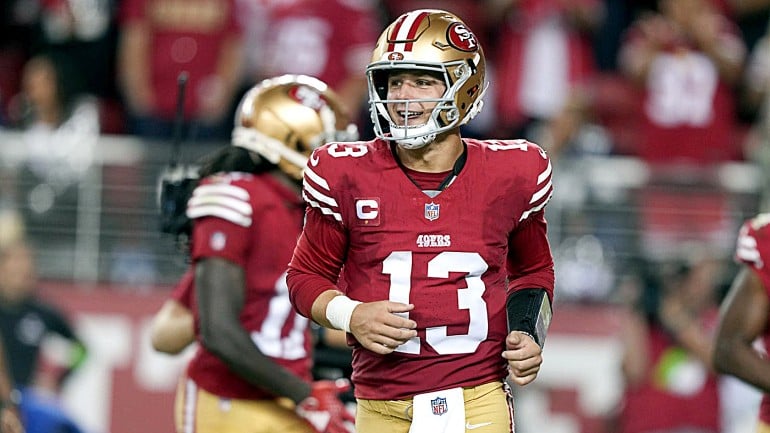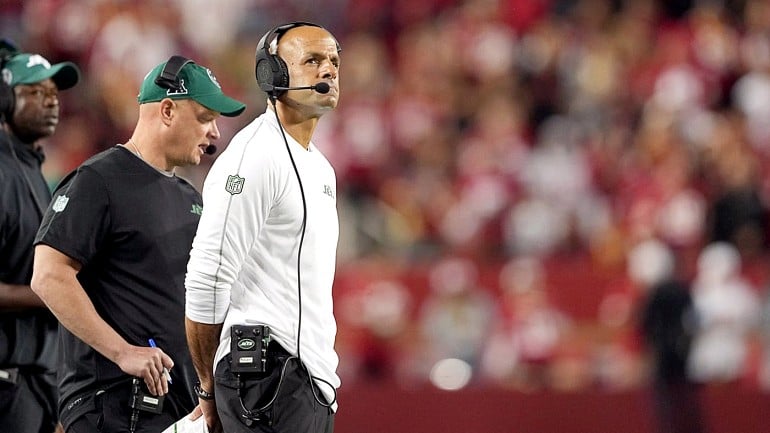This week is a two-part look at how Kyle Shanahan uses the run-pass option (part one) and how he uses the running game to set up the RPO and take advantage of the aggressive pursuit of opposing defenses (part two).
Since the 2017 season, much talk has centered around the use of the "run-pass option" (RPO) in the NFL, especially since the Philadelphia Eagles used it heavily in their Super Bowl run. Commentators and fans alike have called it out with an enthusiastic zeal, mainly because in some cases it's easy to spot and it's a play that has more success than not.
Last week in a response to a question from 49ers beat writer Grant Cohn about using RPOs in the red zone more, Shanahan responded:
"I've done them for the last 15 years. The RPO questions are getting hilarious to me. It's not just you, it's the whole planet right now. I know Philly had success with them in the playoffs. That's' what every team in the NFL does, and they still are. It's just something that all defenses have to deal with and when they're there, it's great to put those guys in binds."
The question gets at the heart of the craze over the RPO, namely that it is hard to spot at first glance and Shanahan does not run the RPO the way the Eagles and other teams run it. Cohn asked why not use it in the red zone more often and Shanahan replied that they did that "It got tipped...we definitely tried one yesterday and we wasted a call trying it because it didn't work."
He's right, it didn't work (more on that later in part two), but it's a play Shanahan has been using long before someone like Chip Kelly came into the league with his spread offense concepts (which the Eagles still borrow heavily from). The Shanahans have been using RPOs since at least 2012 when they drafted quarterback Robert Griffin III and implemented the pistol formation and the post-snap read RPO into their already-hybrid West Coast offense playbook.
There are two types of RPOs currently in use in the NFL: pre- and post-snap read RPOs. 49ers head coach Kyle Shanahan has incorporated both into his playbook throughout his coaching tenure.
PRE-SNAP RPO
In the pre-snap read RPO, the quarterback is either making a box-count read during which he counts the defenders in the box or a ratio read during which he's reading the number of defenders from a certain point on the field up to a certain level, usually 10 yards down field from the line of scrimmage.
Box Count
If there are more defenders in the box than the offense has blockers for, then the quarterback should chose to throw the pass portion of the play. If the number of blockers match or outnumber the defenders in the box, then the quarterback will hand the ball off to the running back.
In every variant of the RPO Shanahan uses, the play is combined with the outside zone run. You can see this in the movement of the running back and offensive line as they move to reach block and get up field to the second level on their outside zone run blocks. Against the Raiders in Week 2 of 2016, Matt Ryan hit tight end Jacob Tamme for a 15-yard gain on this RPO off of the outside zone-run blocking scheme.
It's important to note that in any RPO, to sell the play, the linemen and running back do not ultimately know where that ball is going so they must stick to their assignments. This is an important distinction in diagnosing the RPO on the TV screen: the movement of the offensive line.
A simple play action pass is not an RPO if the offensive line drops back in a pass set. However, if they get up field and show run blocking movement, especially in the second level, then it's a good sign the play is an RPO. The Eagles will blend the two blocking sets and pass protect on the side with the pass concept and run block in the opposite direction.
Another good example of pre-snap box count read RPO came in week two of 2017 against Seattle. The Seahawks have seven in the box against six 49ers blockers (five offensive linemen and one fullback). Quarterback Brian Hoyer fakes the outside zone and hits tight end George Kittle for an eight-yard gain on essentially the same RPO as the one above.
Right away, Hoyer notices the strength of the defense is set to the left side of the offense's formation. At the snap, the defense flows in the direction of the outside zone blocking, leaving a void in the middle of the field vacated by the linebackers. The defense pursues the run, but Hoyer turns and throws off the simulated run fake to a wide open Kittle in the void in the zone where the defense vacated.
Ratio Read
In the ratio read, the quarterback is simply counting the number of defenders covering the particular passing route on the RPO. Usually the concept is a simple bubble screen and if there are more receivers/blockers out wide than there are defenders at a certain level, then the quarterback will likely choose to throw the ball.
An example of a ratio count RPO by Shanahan came in the divisional round playoff game against the Seahawks in 2017. The pre-snap look of the defense right away dictated the direction of the play. The resulting play ended in a touchdown for Julio Jones.
The key for this play is the slot cornerback to the offense's left lined up too wide over the two receiver bunch with Seahawks defensive back Richard Sherman playing off-coverage over the bunch.
Ryan recognized the secondary alignment (Sherman's depth) and the flow of the running back and offensive line helped to draw in the linebackers just enough for Ryan to hit Jones over the middle for the touchdown.
POST-SNAP RPO
The post-snap RPO, commonly run by the Eagles, seeks to put a defender into conflict. The quarterback reads the defender and makes a decision based on what this defender does. The play puts the defender in conflict with the combination run and pass route to the play side. If the defender plays the run, the quarterback throws the seam or slant behind the area from where the linebacker rushed. If the defender plays the pass, the quarterback simply hands off to the running back.
Shanahan is no stranger to implementing the post-snap RPO either, as it was often used as a way to get Robert Griffin III into a rhythm early in games as a rookie.
In 2012 the Redskins employed a number of RPOs that Griffin was accustomed to running while at Baylor. This play in particular has Griffin reading the strong side linebacker for his cue to throw or hand off. If the linebacker plays the run, he'll throw, if the linebacker drops into a zone, he'll hand-off to the running back.
The Falcons linebacker spots a running lane and fills this gap at the first sign of handing off. The rush to the fill gap leaves a void behind him the defense for the tight end to run to.
Griffin pulls the ball out when he sees the linebacker flow toward the line of scrimmage and delivers the pass into the hole in the defense for a first down.
On this play, Griffin actually has three reads, the front side slant or hand off based on what the play side linebacker does, or the backside bubble screen depending on the backside linebacker.
In this case, Griffin pulls the ball when the linebacker fills the gap on the run action and throws the slant behind him into the hole. He could've also taken the chance and thrown the bubble screen on the backside for a gain but chose to stick with the slant.
So what has coach Shanahan been up to since taking over as the 49ers head coach? Running mostly pre-snap read RPOs because of how they fit into his overall offensive theory. So far through two games, the 49ers have run four RPOs, completing two of them and one for a touchdown. Now that we have a better understanding of how coach Shanahan uses the RPO, in part two of this series tomorrow we'll look at the week two win over the Lions and how he uses the run game to set up the option.
All gifs courtesy of the NFL.
All statistics courtesy of Pro Football Reference unless otherwise noted.




